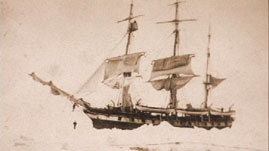Teachers' Domain - Digital Media for the Classroom and Professional Development
User: Preview

Source: The Bishop Museum
This video, adapted from material provided by the ECHO partners, is a dramatization based on the account of an actual voyage by Charles Edward Kealoha, a Native Hawaiian who traveled to Alaska in 1876-77 to participate in the Arctic whale hunt. He and another Native Hawaiian seaman were stranded there and lived among the Iñupiat in a northern Alaskan village for six months. The narrative closes with Kealoha's rescue and safe return to Hawai‘i.
In the nineteenth century, many Native Hawaiian seamen joined whaling crews and traveled to the Arctic. We know about their presence on these trips because of business documents, logs, bills, and other records left behind.
Charles Edward Kealoha, an 18-year-old seaman aboard a whaler bound for Alaska in 1876, wrote a personal narrative describing his experiences on what became a tragic journey. Records show that this year was one of the most disastrous for whaling crews in the Arctic; as a result of bad weather, 11 ships were lost and nearly 60 men died.
Kealoha and another Native Hawaiian seaman were stranded for six months in an Iñupiaq village near present-day Barrow, Alaska, along the Beaufort Sea. Like many stories of voyages — going back at least as far as The Odyssey — Kealoha's narrative shows what happens when cultures meet. It is also a story of survival in a locale that must have been particularly harsh for a Native Hawaiian.
Kealoha's story is an example of one of the most powerful aspects of storytelling: it exposes readers to worlds they didn't know existed and couldn't otherwise imagine. Kealoha originally wrote his story for the Hawaiian newspaper Ka Lähui Hawaii. For those who read the story in the newspaper, this tale of adventure brought to life the experience of one of their own people. For readers today, Kealoha's story remains vivid and exciting purely as an adventure story. However, because later generations continue to read Kealoha's story, it has taken on new contexts and offered new insights.
For scholar Susan A. Lebo, of the University of Hawaii, narratives like Charles Kealoha's story provide the basis for comparing and contrasting information about related events, perspectives, and cultures, and finally putting it altogether into a single history. Professor Lebo has also studied a first-hand account by J. Polapola, another Hawaiian seaman who sailed that season and who witnessed a bloody struggle and mutiny aboard the William H. Allen. By reading critically and comparing accounts, Professor Lebo has gained insights into this little-known world of cultural contact.
 Loading Standards
Loading Standards Education through Cultural and Historical Organizations (ECHO) offers you resources on Teachers' Domain that strengthen knowledge of local culture and identity.
Education through Cultural and Historical Organizations (ECHO) offers you resources on Teachers' Domain that strengthen knowledge of local culture and identity.
